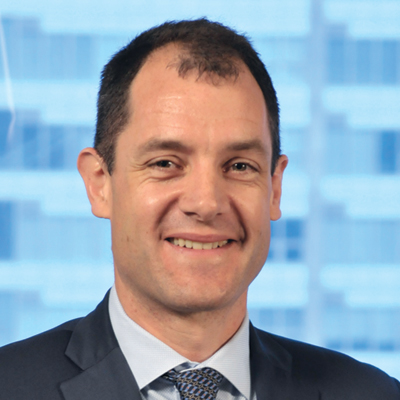Insurtech: Trucking Industry
Data Driven
Protective Insurance’s CEO: Trucking data is the key to mitigating losses on the road and in the courtroom.
The Insurtech Special Section is sponsored by Cambridge Mobile Telematics. Click on the microphone icon to listen to the Cambridge Mobile Telematics podcast or go to www.ambest.com/ambradio.
Commercial trucking insurers must use the data they collect from telematics, electronic logging devices and geospatial information to connect with their customers to improve their safety environment, said Jeremy Johnson, chief executive officer, Protective Insurance. The trucking industry also is facing escalating attention by the plaintiffs' bar and data will be part of a solution to the growing litigation, he said.
Johnson spoke with AMBestTV at InsureTech Connect 2019, held in Las Vegas.
Following is an edited transcript of the interview.

Our customers [are] facing escalating attention by the plaintiffs’ bar, which is raising their costs. I think for us the challenge is how can we make them safer?
Jeremy Johnson
Protective Insurance
You took over at Protective last May. What are the tech improvements you're looking to bring to the company?
We've been focused on the trucking space for over 50 years. I think the data that we have—our claims data, the data on our customers—enables us to bring a lot of value to our customers.
The challenge and the opportunity is really to build connectivity. Not just pipes to our customers, but to connect into a myriad of different burgeoning data sources, whether those are the [electronic logging devices] in the trucks, or other telematics information, or geospatial information, or environmental data, or data compiled on particular roads, for example, and to be able to get that data.
Then to be able to build the infrastructure, the technology infrastructure, and invest in the people who can analyze that data. Then find the predictive signals so that we can then help our customers to improve their safety environment, and ultimately to make the roads safer.
That seems like a really tall task. You have all of this data, and you need to analyze it somehow. Is that requiring partnerships with insurtechs?
The insurtech space is fascinating. There are so many super intelligent people leveraging data science and sensor technology and trying to help companies like us, the industry that we serve, the trucking industry, to be better and to be safer.
We will need to partner with outside companies. We've got a couple of really great partnerships that we'll be announcing shortly to build better platforms to collect, collate and analyze data, and to find those predictive signals.
At the same time, we have to invest internally in the resources to mine our own data, and then to match our own data with the external data sources that are becoming more and more available to us.
The commercial auto trucking space has struggled with profitability. What is driving the losses?
There's been an increase in deaths on the road over the last handful of years, which is a tragedy. Thirty-eight thousand people died on the roads [in 2018] in the U.S. I think as an industry, we can help to bring those numbers down.
You've also got a huge focus by the plaintiffs' bar, by a handful of plaintiffs, on the trucking industry, and on, how to say, leveraging our judicial system in a way that wins colossally outsized verdicts in what are certainly tragic cases. But the dramatic escalation in the verdicts that some of the plaintiffs' attorneys have been able to extract from the trucking industry is kind of unconscionable.
It's one of the reasons why the industry has struggled to make money, because that escalation in loss costs over the last five years has been dramatic, and it doesn't seem to be slowing down. As an insurance partner for our customers, we have to be super focused on how we can lower their exposure.
How can we make them safer? How can we help them, if they do have a claim, manage that dynamic with a very skilled plaintiffs' bar super focused on the trucking industry?
You also have a class of equity investing, litigation finance, that is pouring money into capitalizing, into making these cases go forward, investing in them, which has some unfortunate outcomes for our clients, and is raising the value, I suppose, for want of a better word, of the settlements, and in some cases, the verdict.
Our customers already, they're facing this escalating attention by the plaintiffs' bar, which is raising their costs. I think for us the challenge is how can we make them safer?
How can we use the technology and the data that's available? How can we take the data that comes from the federal government, for example, and help them understand whether they have repeatable inspection violations? How can we drive loss prevention programs for them, specifically for a group of drivers, that might reduce that profile?
How can we use the telematics data that so many of our motor carriers are producing a huge amount of telematics information on where they drive, how their drivers drive, what routes they take, how they choose their routes? Can we get that data, analyze that data, and then help our customer to understand perhaps the particular time of the day they might want to take a different route?
Perhaps they might want to build a program that financially incentivizes the drivers to change their behavior, because their behavior is identifiable from the telematics.
Then how can we understand some of the software/hardware combinations, the collision litigation solutions that sometimes are built into the trucks when they're bought, but sometimes come as after-market solutions? It's quite a complex playing field for our customers to try to understand what solution is going to be the best fit for us.
The insurance industry can help our customers to look through those different solutions for the one that's going to hopefully make them safer.
Are customers receptive to that kind of partnership with an insurance carrier?
I'd say for us at Protective, we try to do business with customers who are de facto safety-focused. So, yes, they are receptive, because they want to know how they can be more safe. For many truckers, there's a balance of where you spend your money.
Spending money on safety ultimately will reduce their insurance premiums. It will reduce their loss costs. It will make them safer. Hopefully, they can then hire better drivers, help create a better safety culture.
We're seeing more and more receptivity, but does depend on the trucker. I think for smaller fleets, it's more of a challenge balancing that cost equation. Do they spend money on drivers or on fuel, or do they spend money on safety advantages in the cab?
More and more the climate is such that if you're going to be a successful trucking company, you have to make the investments in safety.
You had mentioned litigation. Can you use data to show that the truckers weren't at fault? Or does data have a double-edged sword?
It's definitely a double-edged sword. You can use the data to hopefully make the risk more safe. You can use the data to build coaching programs for drivers. That's a very popular technique, building coaching programs for drivers.
At the same time, so much of that data is available to the attorneys. If the data indicates that maybe there was a safety problem, or an inspection violation, or a speeding problem, or in some cases, a drug and alcohol problem, then that can make for a really bad case.
That data is very available. Certainly, the plaintiffs' attorneys are investing in accessing that data and analyzing that data themselves. So it's absolutely a double-edged sword.
One of the big issues in private passenger auto is autonomous vehicles. Is that coming to trucking as well? And how far off?
Most of the OEMs (original equipment manufacturers) are absolutely investing huge amounts of money in understanding autonomy, and getting to level 4, level 5 autonomy, where a vehicle is driven without a driver. I believe, we're a long way away from that really being live on the highways and in the cities.
The immediate benefit is those investments in autonomy are helping drivers—the collision avoidance systems that can take over if a driver is veering off, automatic braking that can brake the truck if it's about to hit something, understanding the trajectory of a vehicle as it maybe takes a curve too quickly that can prevent a rollover.
The investments in technology and understanding what makes a truck move, and the environment around it, is absolutely helping make for a safer environment. But I do think with the number of vehicles on the road and the complexity of driving through a city, I think we're a long way away from full autonomy.
[We] have spoken about platooning. Maybe that's something that we'll see before we see full autonomy, where perhaps you have a vehicle with a driver, but then an autonomous vehicle following it.
That seems to me like that's probably a more logical interim step than expecting a fully autonomous vehicle on our highways or in our cities. I don't see it in the next handful of years.



























